The bus from Zaragoza to Jaca takes two and a half hours and when I got out of it at my final destination of the day and headed for the hotel I was delighted with the gorgeous blue sky and the perfectly clean air. Jaca is situated at 820 meters above sea level.
As I was checking myself at the hotel, the receptionist informed me that Serbia was leading Costarica at the World Cup in Russia. It was 1:0.
So, I left my things in the room and went out for a walk around Jaca. In fact, I first headed for the Church of St James (Iglesia de Santiago), since it is possible to buy a pilgrimage passport there. It was a Sunday afternoon and the church was closed. Still, I thought there was no need for me to panic, since I would certainly have the following morning free and Jaca is a small town.
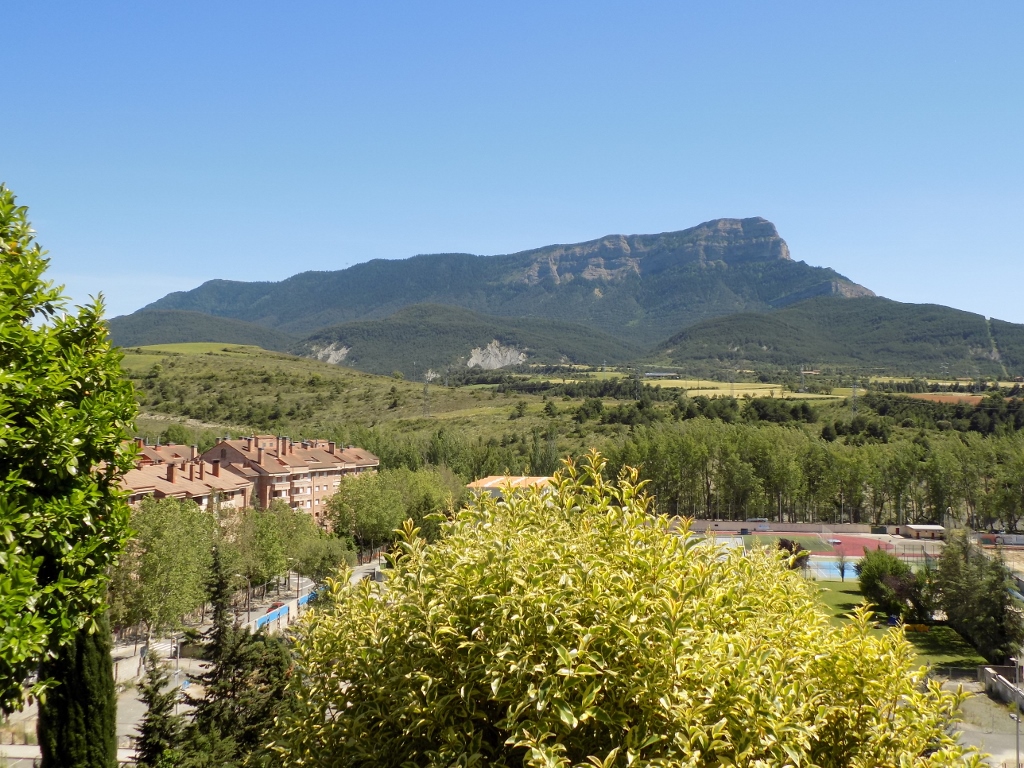 Surroundings of Jaca
Surroundings of Jaca
I continued roaming around Jaca. I was still delighted with the wonderful, clean air and the town was surrounded by nice landscapes, too. I took a map of the place back at the hotel which was good since the tourist information office was closed. Thus I visited a couple of interesting points and then I sat at a bar to have a coffee. After all, I had no major plans. I had already decided before that I would go to the tourist information office the following day in order to get some more information that I needed. And then I decided to go to the Citadel (Ciudadela), i.e., a local fortification.
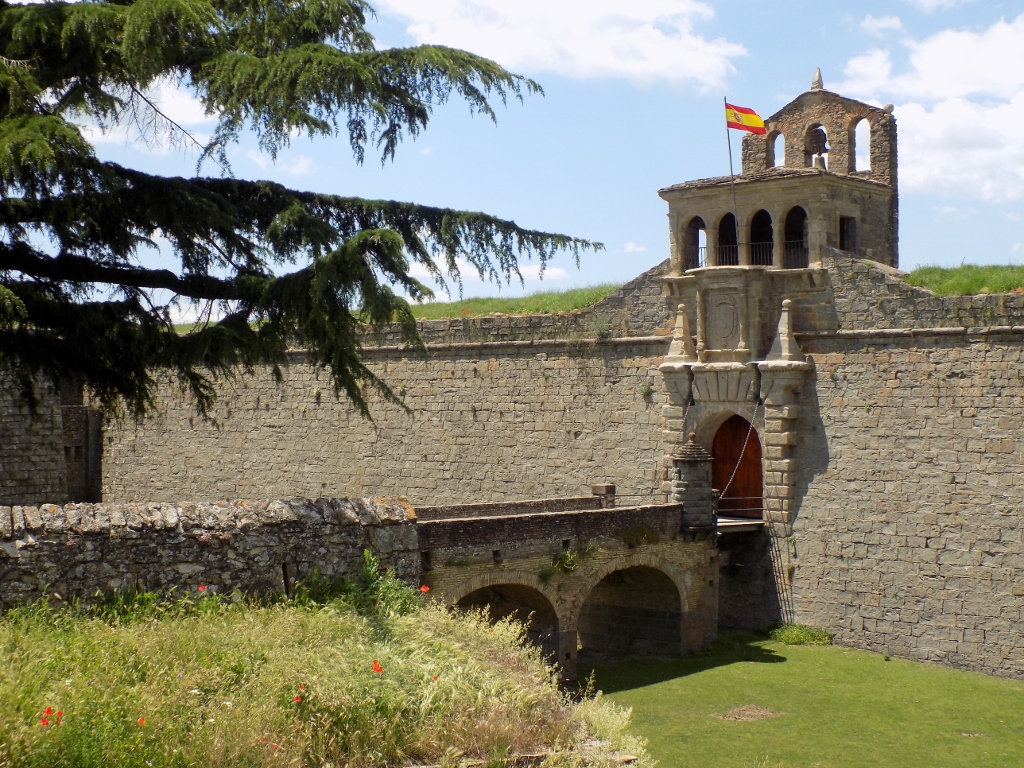 Entrance into the Citadel
Entrance into the Citadel
The way I understood it at the ticket office, it is still considered a military facility and for this reason it cannot be visited individually, but only as a part of a guided group. The group tour was to start in around half an hour, so I went for a short walk around the neighbourhood, returning soon. Then I bought a ticket and sat on a bench in order to wait for other visitors to gather. The start time was getting close and I thought I was the only idle person who had decided to visit the military facility in Jaca, but as it turned out there were three other visitors as well. We eventually went for the sightseeing tour around the fortification, the guide was speaking in Spanish, of course, and I was delighted that I actually understood all of it. I did not regret coming here for the visit.

Because of its strategic position, close to the border with France and the very busy Somport pass in the Pyrenees, all of this being in the valley of the Aragon river, a citadel in the shape of a perfect pentagram was built here in the 16th century. By the way, Jaca was also the first capital of the Kingdom of Aragon (11th century). Today, the Citadel is still considered a military installation, but it all appears very peaceful, including also the deer who leisurely graze on the grass growing in the dry moat around the fortification.
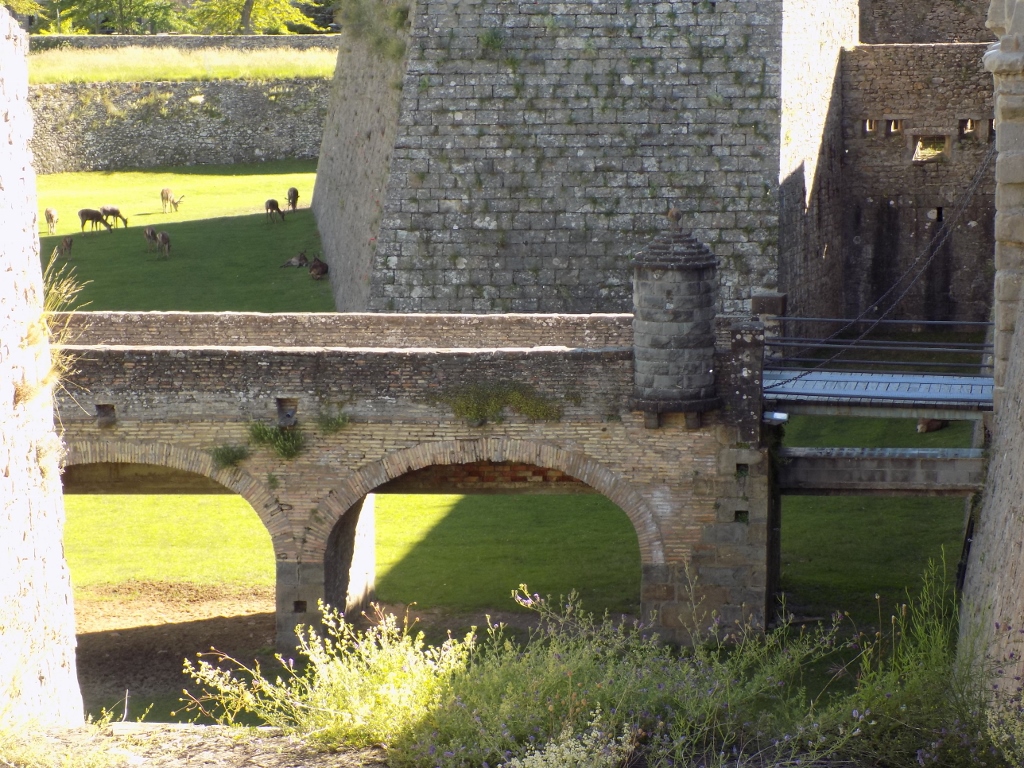 Entrance into the Citadel, along with the deer
Entrance into the Citadel, along with the deer
The visit was rather interesting and the last place to see was a chapel and while the guide was speaking about different aspects linked to the painting that is placed in the middle of the sanctuary, I noticed two icons on both sides of the painting. So, I went near them and noticed they were SERBIAN icons: St Nicholas and St George. Their names were clearly written in Serbian. I asked the guide how the icons ended up there and she told me that some people had been in Serbia and then they had brought them to the chapel. Although I did not want to exaggerate things, I still decided to interpret this as a sure sign that I was in the right place.
Following the sightseeing tour, I passed through the central streets of Jaca and when it was slightly after 7 pm, I decided to walk over to the Church of St James (Iglesia de Santiago) again. It was open this time, but when I went in, it seemed pitch black and apparently empty. Then I saw a man who was sitting in a corner and prayed, but I thought it would be to say the least rude of me to interrupt him. I just thought I would come again the next day and perhaps there would be somebody to ask when I saw a young man enter the church and knock on the door that was to the right from the entrance into the church with a sign Office (Oficina) on. So, I followed him, knocking on the door myself, peaking in and asking if I could get a pilgrimage passport there, and the gentleman who worked there said I could. Wonderful!
He first registered me in some book under the number of 200, which I liked being such a nice and round number. Then he also gave me the “passport” in which I wrote the basic data and then he stamped it and showed me where I should put the first pilgrimage stamp at the Somport pass the following day. I was very happy and grateful. By the way, the pilgrimage passport is called credencial in Spanish and it costs 2 euros.
There is one thing I have to clear up right away. For some completely unclear reason, almost everybody gives their own data on the distances and how much different places are away from Santiago de Compostela. The difference exists even in the data given, for instance for the distance between Jaca itself and Santiago, by the Cathedral of St Peter in Jaca (829 km) and the one written in the credencial (837 km). Therefore, in the continuation of the story on the way in which I walked the Way I will use the data provided by the passport, except in the case when I mention places for which no data are provided, although even then I will state the distance which I have calculated on the basis of what has been written in the pilgrimage passport.
After this very successful mission, the time came for me to sit down and eat something, so I went to the very centre of the town and the Cathedral of St Peter the Apostle. This is the oldest Romanesque cathedral in Spain and it was built in the 11th century.
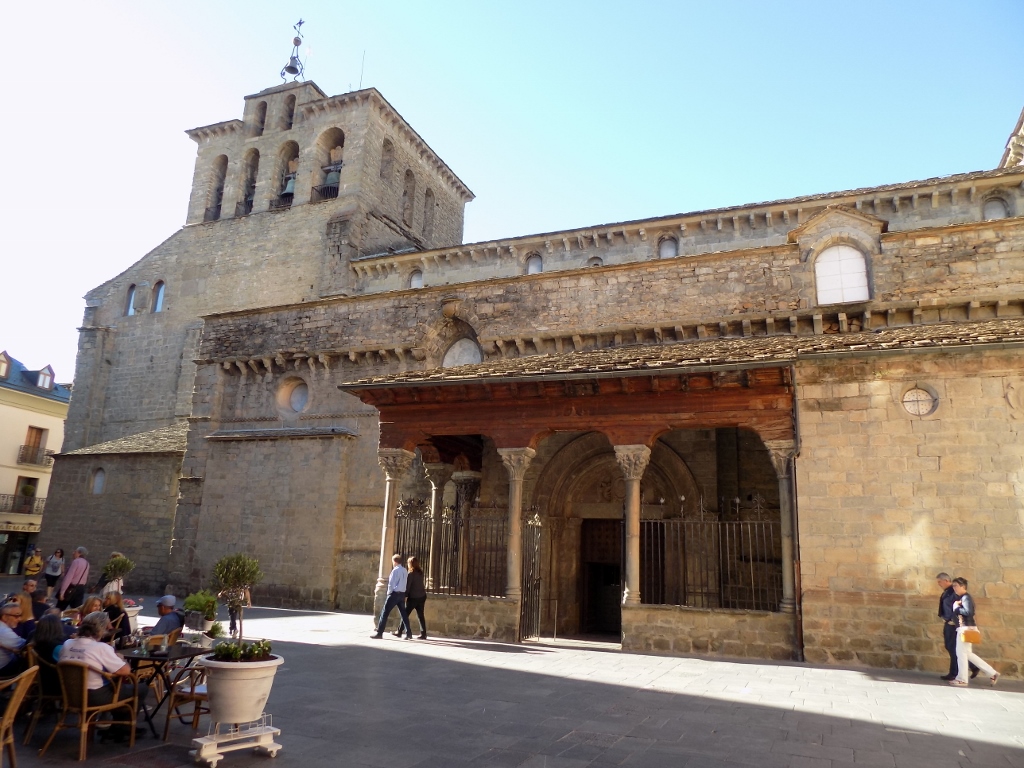 Cathedral of St Peter the Apostle
Cathedral of St Peter the Apostle
I chose to sit at a café right across the Cathedral and there I ordered beer and tapas – small appetizers. The Spaniards are true masters of this. They prepare these small, but very imaginative and tasty pieces of food that are the right thing to nibble while having a drink, whether this is beer or wine, and they can certainly be eaten on their own. In order for me not to be bothered with something I basically don’t know much about, I asked the waiter to bring me two pieces of his own choice. And they were fantastic!!!
Afterwards I realised I still had some empty space in my stomach, so I ordered two more pieces, but asked for them to be different. And they were, but still fantastically tasty.
I sat there in the square for a little while and then decided to go back to my room and get ready for the night’s sleep for tomorrow was a very important day – I should start with my Way of St James!
I woke up in the morning feeling quite fine. I still kept feeling attacks of stage fright, but there were essentially no problems. I even walked around Jaca for some time and went to the nearby San Miguel bridge (Puente San Miguel) that spans over the Aragon river.
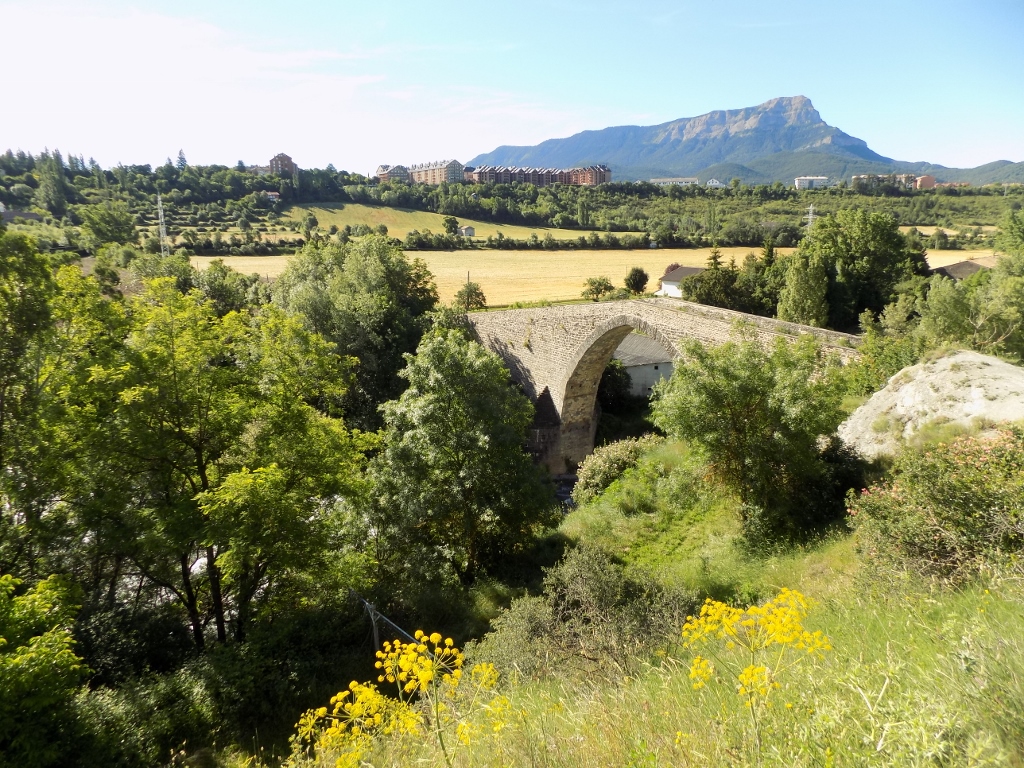 Puente San Miguel
Puente San Miguel
Then I returned to the hotel at some point, packed up my things and headed for the coach station. Still, before leaving the hotel I did one more thing. Namely, on this day I started informing my Facebook friends about the project. At the very beginning I did not have any idea what it would look like in the end, but my first “report” consisted of the map of the Way I planned to cross, as well as the length I was to cover. As I’ve mentioned earlier, for my calculation of the length of the Way I used the “official” figure that is stated in the credencial, i.e., the pilgrimage passport. Along the Way, one comes across very different data on the distance and how much is left to Santiago, but in order to be consistent I had decided to use what is provided in the document issued by the Church.
My first post was as follows:
Day 0: “Making the first step”
Way of St James, the Aragonese route
In front of me: 867 km
Behind me: 0 km
The bus left Jaca at noon sharp and it drove up the valley of the Aragon river to the Somport pass at the very border between Spain and France.
There I got off the bus at a stop that is right by the pilgrims’ hostel (albergue) Aisa and that is an important place because this is where I got the stamp that marked the beginning of my pilgrimage. The Somport pass has always been a very important pass in the Pyrenees and from there towards the south spreads the valley of the Aragon river. I truly enjoyed the landscapes as I climbed in the bus towards the pass that is situated at the altitude of 1632 m a.s.l., but after I got that stamp, I put my big backpack on my back, the small one in front of me and I took the trekking poles in my hands. I also recited “Our Father” and said “May God help me!,” crossed myself and started to walk. After all, I think we can never have too much help, especially if it comes from the higher powers.
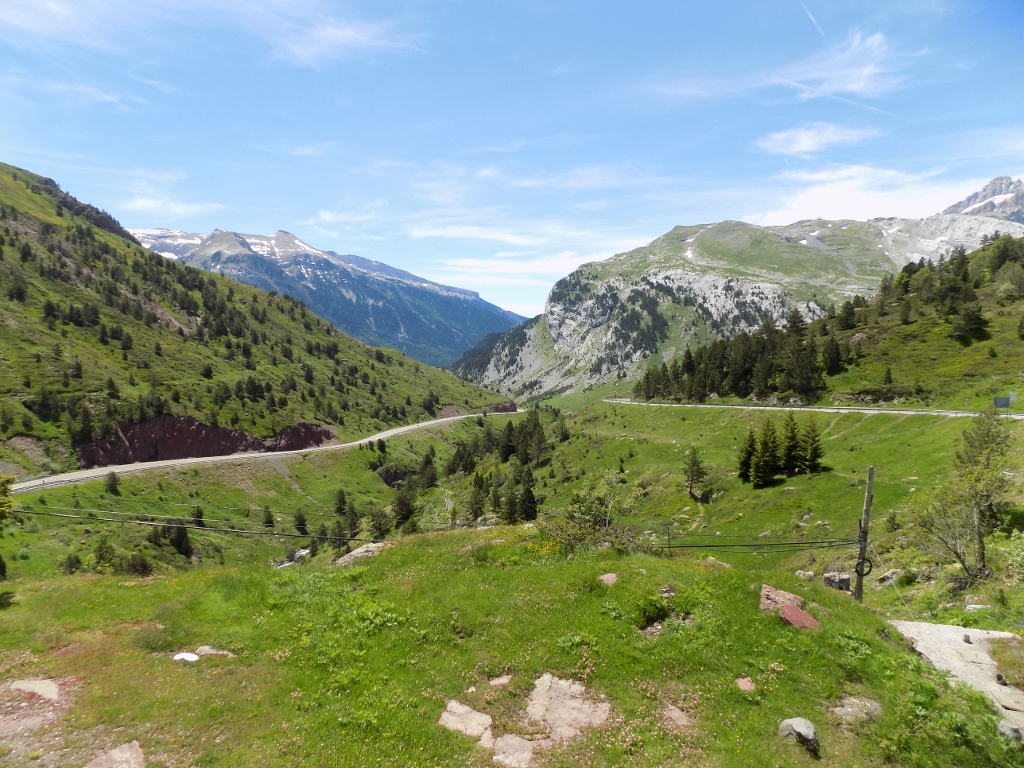 View from the Somport pass towards Jaca
View from the Somport pass towards Jaca
So, the walking started. That first part often consisted of rather narrow paths occasionally with sharp decline, which rather slowed down my movement. Practically, in this section the Way follows the valley of the Aragon river that is here but a slightly bigger stream.
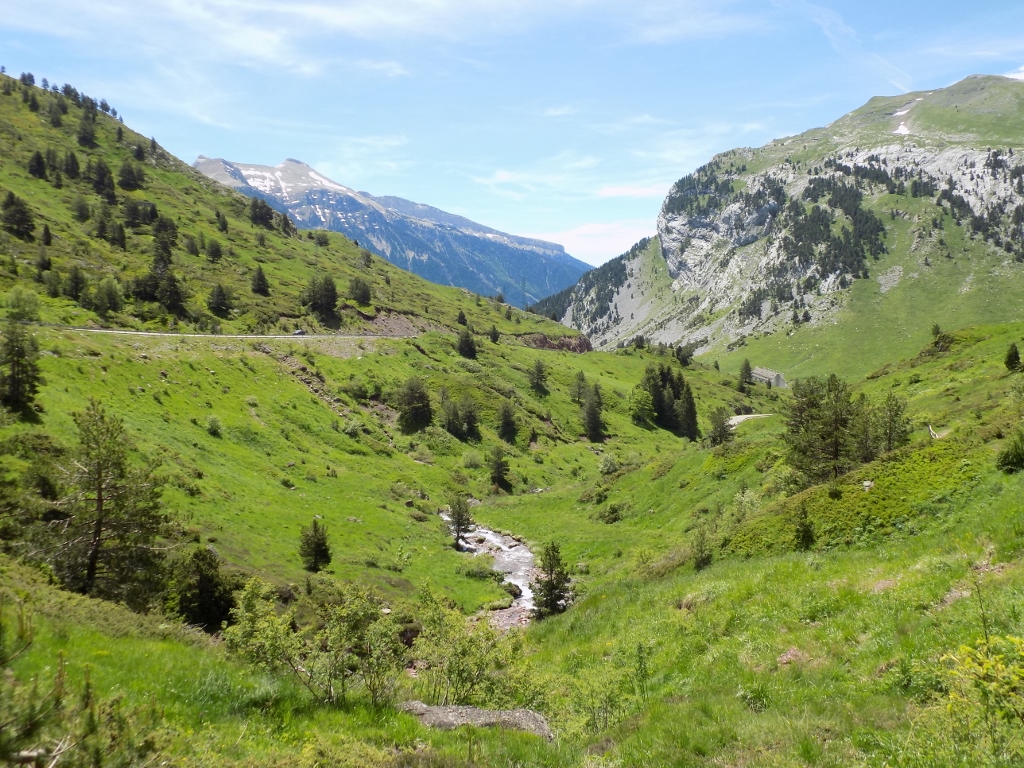 Valley of the Aragon river
Valley of the Aragon river
Then at some point the path became a little wider, but although it often led through forest and over soil, even more often it led over smaller or significantly bigger chunks of stone, so I had to tread very carefully. Of course, when it was most difficult I did not take out my camera, for it was in the waist bag, over which I had my small backpack, and therefore it was not handy for me to fiddle with the camera, but rather I had to focus all my concentration on where I was putting my feet in order not to twist my ankles.
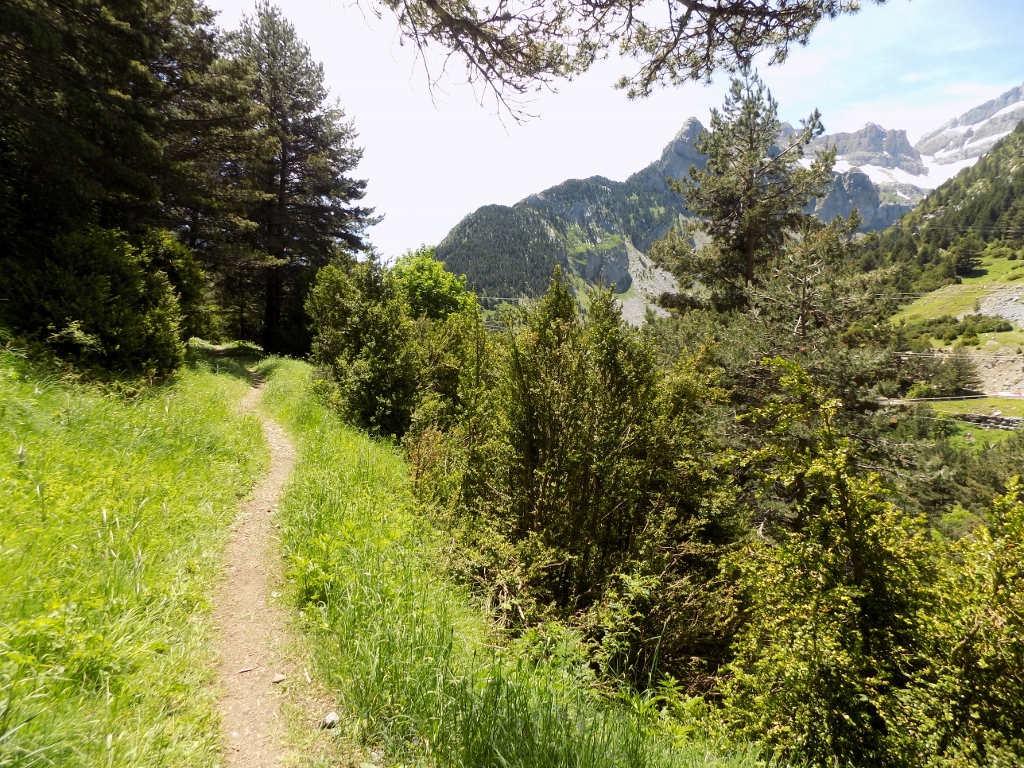 Way of St James in the Pyrenees
Way of St James in the Pyrenees
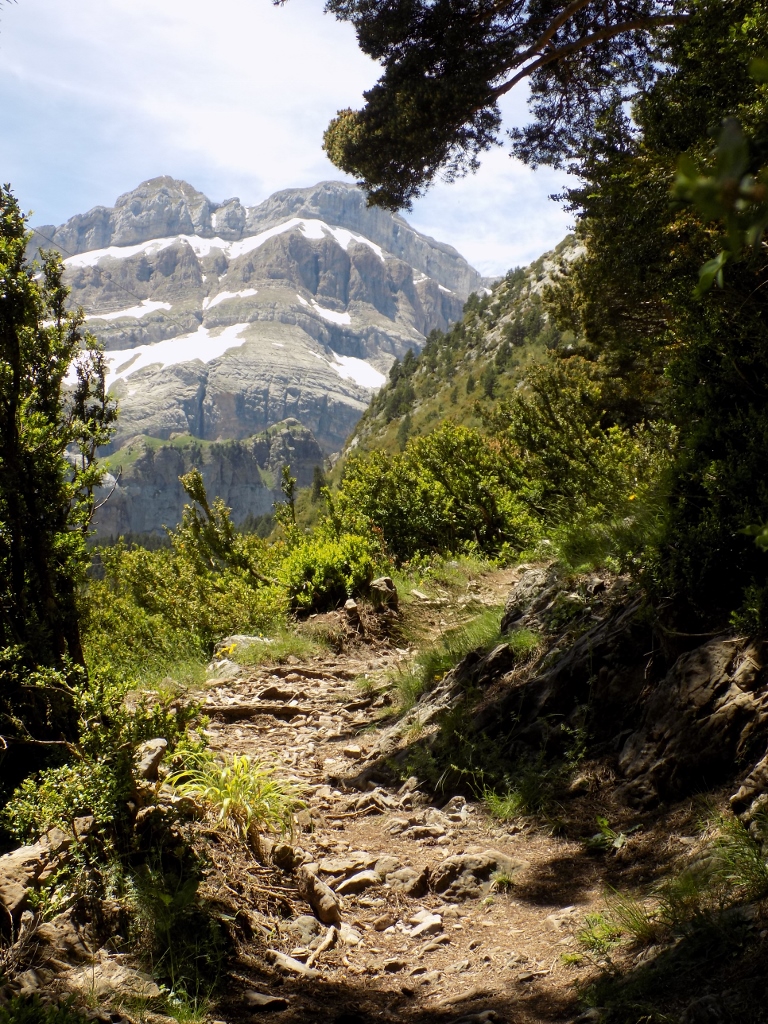 Way of St James in the Pyrenees
Way of St James in the Pyrenees
Still, the landscapes were truly breathless and I was very happy and content that I started my Way from the Somport pass.
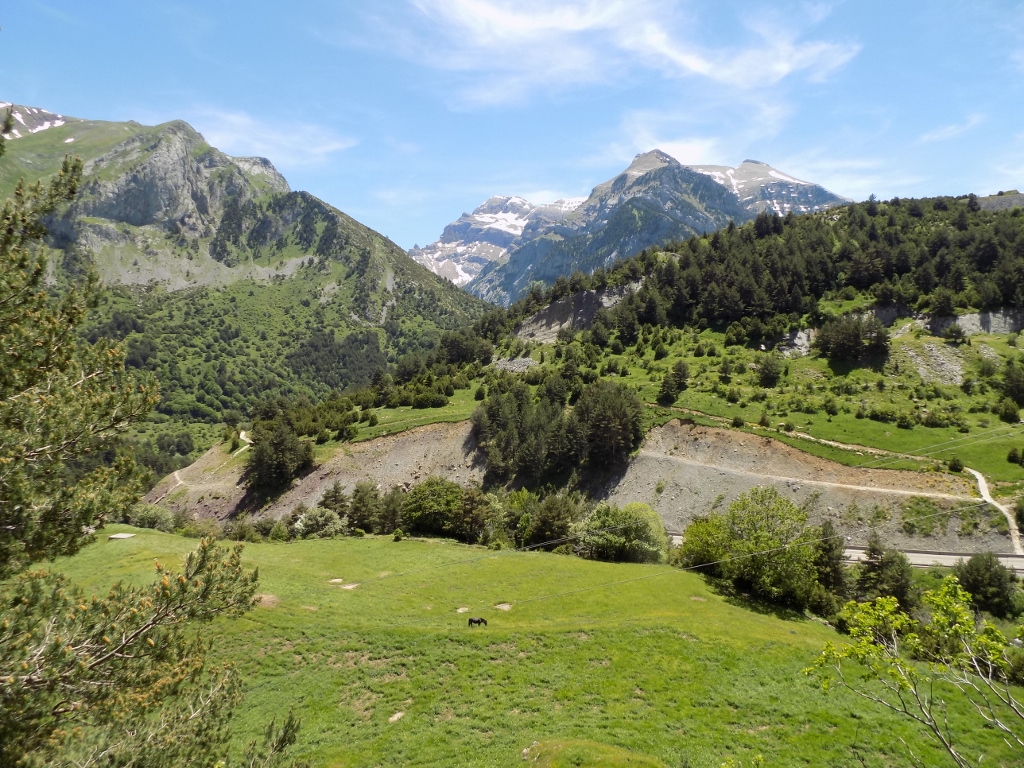 The Pyrenees and the valley of the Aragon river through which both the road and the Way pass
The Pyrenees and the valley of the Aragon river through which both the road and the Way pass
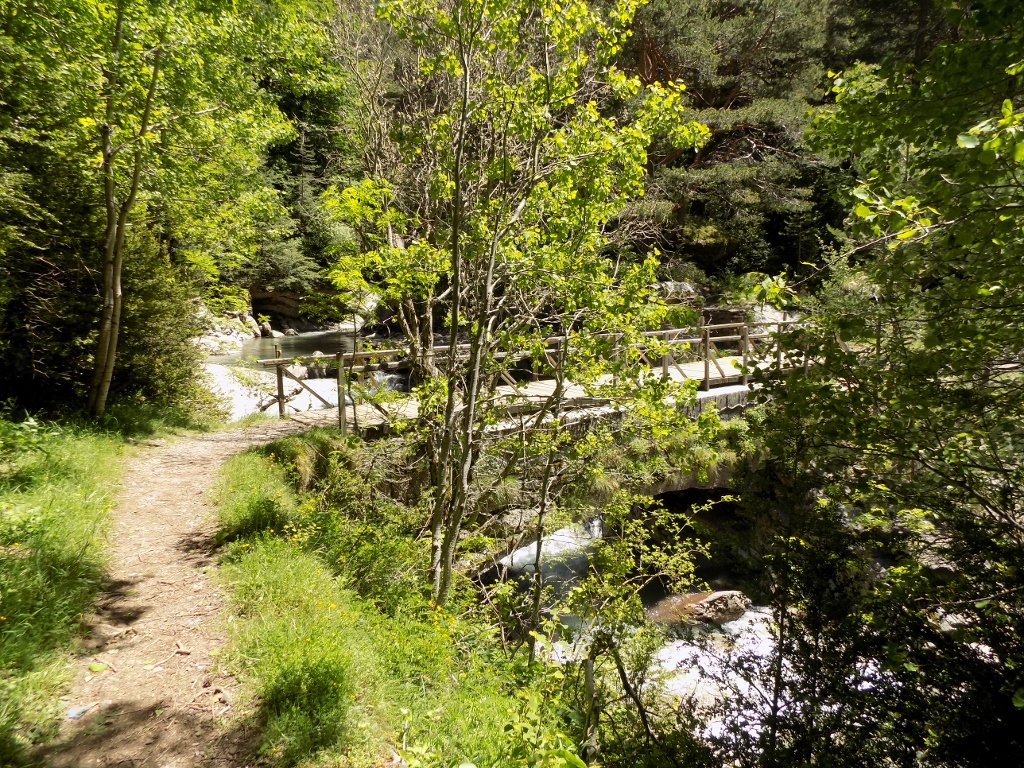 Bridge over a tributary of the Aragon river
Bridge over a tributary of the Aragon river
The first place I came across was Canfranc Estación, which means Canfranc Station. The huge building of the railway station appears quite unusual in the middle of the narrow valley. There I had a short break, taking some refreshments, and then I continued to Canfranc itself where I planned to spend a night at an albergue. In the meantime, the landscapes continued being beautiful and when I got to a bridge with a wide railing, I could not help myself and had to take a photo of me with the big backpack on. I left the small one near the camera, for I found it difficult to run and get myself into the photo position with both backpacks on.
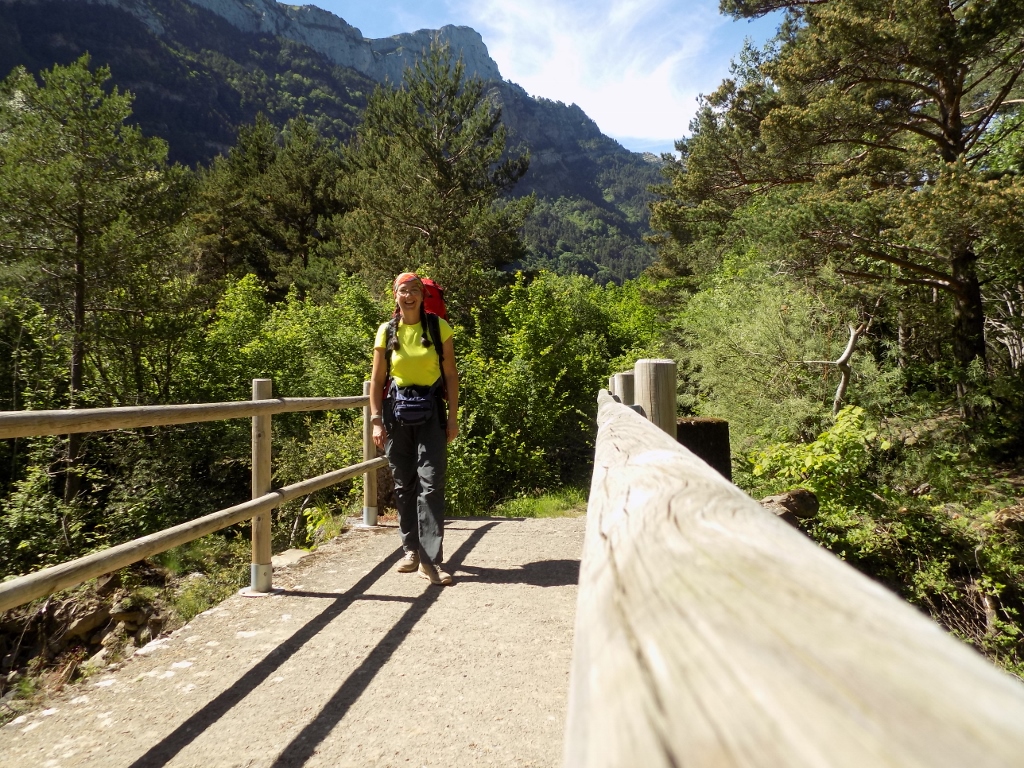 Posing for myself
Posing for myself
When I got to the albergue in Canfranc, the entrance door was wide open, but everything inside was locked up. There was also a message saying that whoever left the message “will be right back and in case of emergency please call xxxx…” I decided to believe they would be right back, so I sat in front for a little while. Then I realised nothing was happening and since there were a couple of guys unloading some drinks into the yard next to the albergue I decided to include into the situation my inner “damsel in distress,” so I told them I didn’t have a Spanish mobile and if I could ask them for a favour that they dialled the number. Of course they obliged and dialled the number, but nobody answered. So, I kept sitting there, even going to a nearby square where there was a drinking fountain with wonderful fresh water and I filled up my water bottle, after which I went back to continue waiting. I could see that nothing was happening and just as I was starting to wonder what I should do, I saw a Guardia Civil vehicle slowly approaching. Since my damsel was still in distress, I waived to the civil guard members and then I explained them my situation, so this time they dialled the phone number and then somebody finally picked up. This is what it means to have the power! Joking aside, it turned out the albergue was fully booked for some children who were there on a sort of a longer excursion and there was no free room or bed for that matter. I got confused, because there was nothing in Canfranc, apart from the fountain, not even a shop in which I could buy something to eat or refresh myself, so a civil guard suggested that I should continue to Villanúa, because it is bigger and I could find accommodation there. Practically I had no choice, so I took the advice. It was 5.45 pm and there was still broad daylight. So, I continued, but I also started to get tired, for I walked rather fast whenever I could in order to make up for the slower sections and everything was taking more than planned.
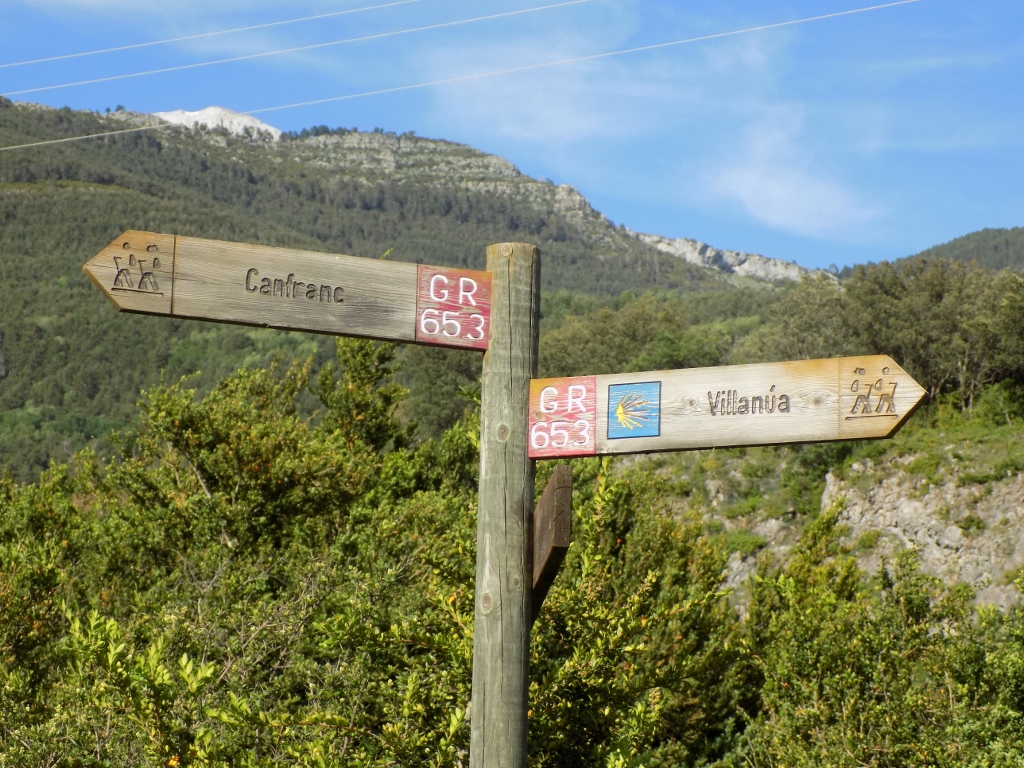 I’m on the right path
I’m on the right path
Still, although I didn’t find it handy at all to take my camera out, every now and then I could not resist, for there were some truly beautiful places I was passing by. Or I was crossing over, as in the case of a bridge over the Aragon.
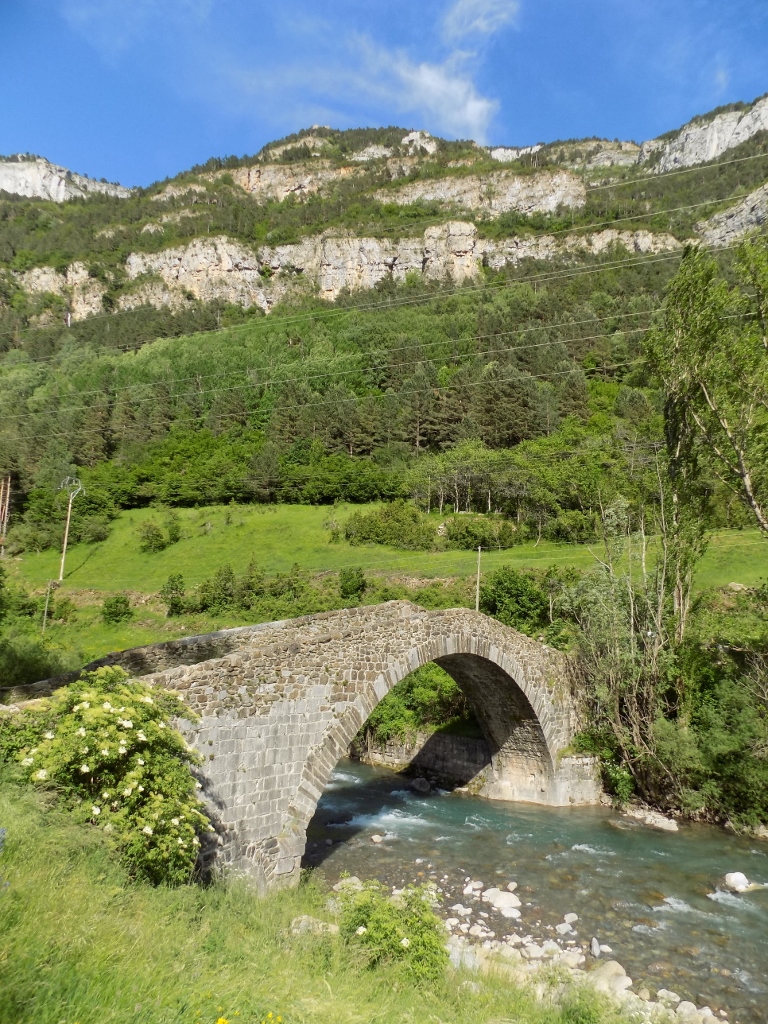 A bridge over the Aragon
A bridge over the Aragon
I arrived in Villanúa around 7 pm and there the path led me to the main road which I then followed. I could see some restaurants and a supermarket, and those signs of life made me delighted. I also saw a hotel. I said to myself that was precisely what I was looking for, but as it turned out it was closed. So, I went back to a restaurant and asked them if they knew of a place where I could spend the night and they directed me towards the centre of the village. To cut the long story short, I kept asking several people and they all kindly pointed me to different places, but they were all closed. Eventually, I made a wide circle around the village, probably passing another 1.5 km, only to get in a rather tired state by now to the very same place from which I first left. Actually, I even went a little farther from the initial point because there was another small hotel there (which I learned along the way), but there was a large group of children there as well. It was obviously the season of school excursions in Spain.
I did ask a woman there if there was any spare room left, but she said there wasn’t any, since the children took up the entire hotel. Then, on the edge of panic I asked her what I was to do since I was a “pilgrim” and she told me there would be a bus to Jaca at 20:45 so I could catch that one. I must say that the same idea had also occurred to me, but I decided to keep it only for an extreme situation. I asked her then if it was possible that there was not a single spare room in all Villanúa and she said she would dial a phone. And so she made an arrangement that I would be put in a small hotel that was actually closed. I even sat there in front of the hotel to wait for her, since she was soon to finish her shift and then she took me by car back to the centre of the village and the place I was to spend the night at since she lived right next to it. Then a local couple appeared (they all know one another) and then they called the owner in order to get the instructions about where to find the key to the entrance door, etc. When we finally got in the things finally started to appear normal – they asked for my passport in order to make a copy, I paid and even got a wi-fi password, and finally they gave me the instructions as to how to leave the place the next day and lock the door behind me.
Still, later I heard somebody else enter the hotel and go up the stairs using the trekking poles, but I was not in the least interested in who else was with me in the building. That night I slept comparatively well. I was a bit worried since sometimes, when I’m too tired, it may happen that I have problems sleeping. Before going to bed I took an aspirin to help me with possible sore muscles, I took magnesium with the B6 vitamin against cramps in my calves and I applied some anti-rheumatic ointment to my collarbones, but I was not sure at all this would help me. Yet, I consoled myself that I would have less burden to carry the following day (approximately 25 grams less).
That night, using a social media, I sent to my friends the following message:
Day 1: “The baby has started to walk”
The previous day a friend of mine asked me: “Has the baby started to walk?” Yesterday no, but today yes. The things got a little complicated – dead season, except for school children excursions, so I barely managed to find accommodation, even extending my walking in comparison to what I had planned, but finally with a lot of luck I got settled fantastically. If I hadn’t spoken Spanish, I could have just as well packed up and gone back home.
In front of me: 851 km
Behind me: 16 km